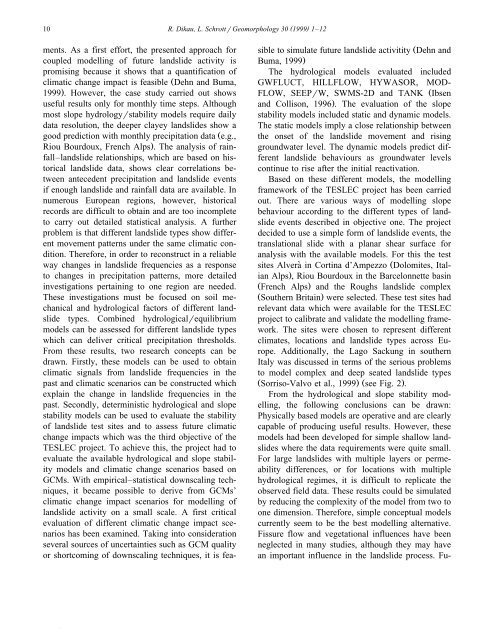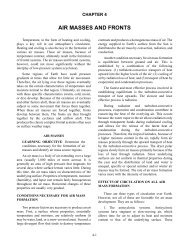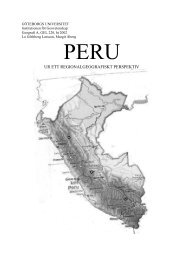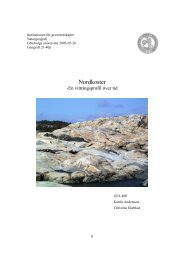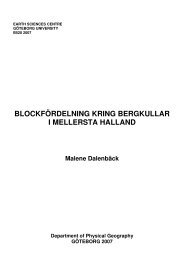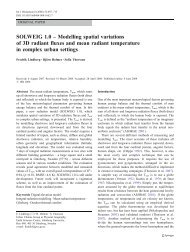The temporal stability and activity of landslides in Europe with ž ...
The temporal stability and activity of landslides in Europe with ž ...
The temporal stability and activity of landslides in Europe with ž ...
Create successful ePaper yourself
Turn your PDF publications into a flip-book with our unique Google optimized e-Paper software.
10<br />
ments. As a first effort, the presented approach for<br />
coupled modell<strong>in</strong>g <strong>of</strong> future l<strong>and</strong>slide <strong>activity</strong> is<br />
promis<strong>in</strong>g because it shows that a quantification <strong>of</strong><br />
climatic change impact is feasible ŽDehn<br />
<strong>and</strong> Buma,<br />
1999 . . However, the case study carried out shows<br />
useful results only for monthly time steps. Although<br />
most slope hydrologyr<strong>stability</strong> models require daily<br />
data resolution, the deeper clayey l<strong>and</strong>slides show a<br />
good prediction <strong>with</strong> monthly precipitation data Že.g.,<br />
Riou Bourdoux, French Alps . . <strong>The</strong> analysis <strong>of</strong> ra<strong>in</strong>fall–l<strong>and</strong>slide<br />
relationships, which are based on historical<br />
l<strong>and</strong>slide data, shows clear correlations between<br />
antecedent precipitation <strong>and</strong> l<strong>and</strong>slide events<br />
if enough l<strong>and</strong>slide <strong>and</strong> ra<strong>in</strong>fall data are available. In<br />
numerous <strong>Europe</strong>an regions, however, historical<br />
records are difficult to obta<strong>in</strong> <strong>and</strong> are too <strong>in</strong>complete<br />
to carry out detailed statistical analysis. A further<br />
problem is that different l<strong>and</strong>slide types show different<br />
movement patterns under the same climatic condition.<br />
<strong>The</strong>refore, <strong>in</strong> order to reconstruct <strong>in</strong> a reliable<br />
way changes <strong>in</strong> l<strong>and</strong>slide frequencies as a response<br />
to changes <strong>in</strong> precipitation patterns, more detailed<br />
<strong>in</strong>vestigations perta<strong>in</strong><strong>in</strong>g to one region are needed.<br />
<strong>The</strong>se <strong>in</strong>vestigations must be focused on soil mechanical<br />
<strong>and</strong> hydrological factors <strong>of</strong> different l<strong>and</strong>slide<br />
types. Comb<strong>in</strong>ed hydrologicalrequilibrium<br />
models can be assessed for different l<strong>and</strong>slide types<br />
which can deliver critical precipitation thresholds.<br />
From these results, two research concepts can be<br />
drawn. Firstly, these models can be used to obta<strong>in</strong><br />
climatic signals from l<strong>and</strong>slide frequencies <strong>in</strong> the<br />
past <strong>and</strong> climatic scenarios can be constructed which<br />
expla<strong>in</strong> the change <strong>in</strong> l<strong>and</strong>slide frequencies <strong>in</strong> the<br />
past. Secondly, determ<strong>in</strong>istic hydrological <strong>and</strong> slope<br />
<strong>stability</strong> models can be used to evaluate the <strong>stability</strong><br />
<strong>of</strong> l<strong>and</strong>slide test sites <strong>and</strong> to assess future climatic<br />
change impacts which was the third objective <strong>of</strong> the<br />
TESLEC project. To achieve this, the project had to<br />
evaluate the available hydrological <strong>and</strong> slope <strong>stability</strong><br />
models <strong>and</strong> climatic change scenarios based on<br />
GCMs. With empirical–statistical downscal<strong>in</strong>g techniques,<br />
it became possible to derive from GCMs’<br />
climatic change impact scenarios for modell<strong>in</strong>g <strong>of</strong><br />
l<strong>and</strong>slide <strong>activity</strong> on a small scale. A first critical<br />
evaluation <strong>of</strong> different climatic change impact scenarios<br />
has been exam<strong>in</strong>ed. Tak<strong>in</strong>g <strong>in</strong>to consideration<br />
several sources <strong>of</strong> uncerta<strong>in</strong>ties such as GCM quality<br />
or shortcom<strong>in</strong>g <strong>of</strong> downscal<strong>in</strong>g techniques, it is fea-<br />
( )<br />
R. Dikau, L. SchrottrGeomorphology 30 1999 1–12<br />
sible to simulate future l<strong>and</strong>slide activitity ŽDehn<br />
<strong>and</strong><br />
Buma, 1999.<br />
<strong>The</strong> hydrological models evaluated <strong>in</strong>cluded<br />
GWFLUCT, HILLFLOW, HYWASOR, MOD-<br />
FLOW, SEEPrW, SWMS-2D <strong>and</strong> TANK ŽIbsen<br />
<strong>and</strong> Collison, 1996 . . <strong>The</strong> evaluation <strong>of</strong> the slope<br />
<strong>stability</strong> models <strong>in</strong>cluded static <strong>and</strong> dynamic models.<br />
<strong>The</strong> static models imply a close relationship between<br />
the onset <strong>of</strong> the l<strong>and</strong>slide movement <strong>and</strong> ris<strong>in</strong>g<br />
groundwater level. <strong>The</strong> dynamic models predict different<br />
l<strong>and</strong>slide behaviours as groundwater levels<br />
cont<strong>in</strong>ue to rise after the <strong>in</strong>itial reactivation.<br />
Based on these different models, the modell<strong>in</strong>g<br />
framework <strong>of</strong> the TESLEC project has been carried<br />
out. <strong>The</strong>re are various ways <strong>of</strong> modell<strong>in</strong>g slope<br />
behaviour accord<strong>in</strong>g to the different types <strong>of</strong> l<strong>and</strong>slide<br />
events described <strong>in</strong> objective one. <strong>The</strong> project<br />
decided to use a simple form <strong>of</strong> l<strong>and</strong>slide events, the<br />
translational slide <strong>with</strong> a planar shear surface for<br />
analysis <strong>with</strong> the available models. For this the test<br />
sites Alvera ` <strong>in</strong> Cort<strong>in</strong>a d’Ampezzo ŽDolomites,<br />
Italian<br />
Alps . , Riou Bourdoux <strong>in</strong> the Barcelonnette bas<strong>in</strong><br />
Ž French Alps. <strong>and</strong> the Roughs l<strong>and</strong>slide complex<br />
Ž Southern Brita<strong>in</strong>. were selected. <strong>The</strong>se test sites had<br />
relevant data which were available for the TESLEC<br />
project to calibrate <strong>and</strong> validate the modell<strong>in</strong>g framework.<br />
<strong>The</strong> sites were chosen to represent different<br />
climates, locations <strong>and</strong> l<strong>and</strong>slide types across <strong>Europe</strong>.<br />
Additionally, the Lago Sackung <strong>in</strong> southern<br />
Italy was discussed <strong>in</strong> terms <strong>of</strong> the serious problems<br />
to model complex <strong>and</strong> deep seated l<strong>and</strong>slide types<br />
Ž Sorriso-Valvo et al., 1999. Ž see Fig. 2 . .<br />
From the hydrological <strong>and</strong> slope <strong>stability</strong> modell<strong>in</strong>g,<br />
the follow<strong>in</strong>g conclusions can be drawn:<br />
Physically based models are operative <strong>and</strong> are clearly<br />
capable <strong>of</strong> produc<strong>in</strong>g useful results. However, these<br />
models had been developed for simple shallow l<strong>and</strong>slides<br />
where the data requirements were quite small.<br />
For large l<strong>and</strong>slides <strong>with</strong> multiple layers or permeability<br />
differences, or for locations <strong>with</strong> multiple<br />
hydrological regimes, it is difficult to replicate the<br />
observed field data. <strong>The</strong>se results could be simulated<br />
by reduc<strong>in</strong>g the complexity <strong>of</strong> the model from two to<br />
one dimension. <strong>The</strong>refore, simple conceptual models<br />
currently seem to be the best modell<strong>in</strong>g alternative.<br />
Fissure flow <strong>and</strong> vegetational <strong>in</strong>fluences have been<br />
neglected <strong>in</strong> many studies, although they may have<br />
an important <strong>in</strong>fluence <strong>in</strong> the l<strong>and</strong>slide process. Fu-


